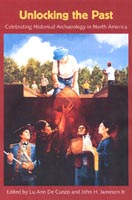Jamestown, Virginia
by Andrew Edwards

APVA Put at Jamestown, Virginia
More than three decades passed before, in 1992, the NPS and The Colonial Williamsburg Foundation (CW) entered into a "cooperative agreement" to conduct further research at Jamestown. The idea behind it was a good one: the Park Service could connect with a not-for-profit educational institution with similar research goals. The NPS would provide financial backing and some facilities, and help cut through "red tape." The institution, in turn, would provide the scholarly framework, educational outreach, fieldwork, and reports. Such was the relationship that developed between Colonial National Historical Park (Jamestown and Yorktown) and Colonial Williamsburg's Research Division. The NPS wanted to assess the archaeology undertaken on Jamestown Island over the last hundred years. We at CW want to learn more about Jamestown because it served as the Virginia capital before Williamsburg. Many of Williamsburg's antecedents lay buried in the ground just six miles down the road.
Our challenge was how to engineer an effective plan to better understand and manage Jamestown Island, both culturally and environmentally. Colonial Williamsburg's Marley Brown and Cary Carson and NPS archaeologist David Orr designed an integrated multidisciplinary approach. They made sure that diverse scholars would evaluate virtually every aspect of Jamestown's cultural resources. As a result, our team included geophysicists, historians, marine scientists, architectural historians, archaeologists, and librarians, along with a variety of plant and soil specialists.
The paleobotanical and microstratigraphic sampling at the borrow pit and the strategic use of archaeology and remote sensing all over Jamestown epitomize the non-destructive approach the team took to achieve the goals of the NPS. But perhaps the best part of the project is that it'll never really be finished. Newer and better interpretations will inform public programming, and new research will address Jamestown's role in the seventeenth-century Atlantic world and its impact on the local environment.
